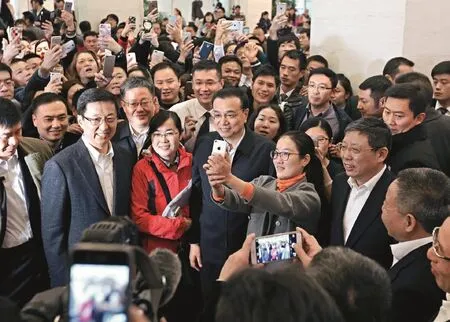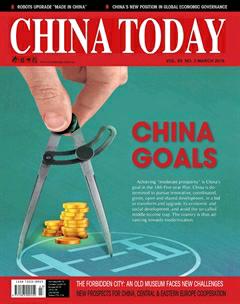How Will FTZs Change China in the New Round of Opening-up?
By special correspondent LIU QIONG
How Will FTZs Change China in the New Round of Opening-up?
By special correspondent LIU QIONG
WHENEVER Chen Jun from Shanghai has time to spare while on business trips to New York, he goes to see a Broadway show. The 38 theaters in the 12 blocks adjacent to Times Square at the junction of Broadway and Seventh Avenue, showing top-line dramas and blockbuster musicals like Cats and Phantom of the Opera, draw theater-goers by the thousand.

Chinese Premier Li Keqiang visits the Shanghai FTZ on November 25, 2015.
But it won’t be long before live theater aficionados like Chen Jun will be able to see Broadway productions in China. Nederlander Worldwide Entertainment (NWE), one of the “big three” Broadway theater owners, has registered China’s first foreign-invested performance art company in the Shanghai Pilot Free Trade Zone (FTZ). NWE has plans at its initial stage in the Chinese market to invest billions of U.S. dollars in four to five theaters. This means Chinese audiences will be able to see more Broadway productions at the same time as audiences in the U.S., as well as touring shows.
NWE leads the way for the entry of other non-mainland theater companies into the Shanghai FTZ. Among them are agencies of Taiwan theater director and playwright Stan Lai (Lai Shengchuan) and the South Korean Nanta Show.
Foreign investment access to the entertainment sector is one of the FTZ’s main attractions. Last year’s negative list for China’s pilot FTZs – in Shanghai, Guangdong, Tianjin and Fujian respectively – scrapped the requirement for a Chinese controlling stake in locally op-erating performance art companies. The latest negative list slashed the items on its 2014 predecessor from 139 to 122, a 12.2 percent reduction.
The FTZ strategy has been written into China’s 13th Five-Year Plan (2016-20), which recommends Regional Comprehensive Economic Partnership (RCEP) negotiations and an Asia Pacific free trade agreement on setting up a FTZ network that embraces global markets.

A country music band from Mexico performs in a shopping mall in Tianjin FTZ where customers are drawn by a wide range of imported goods.
Multiplier Effects
“As Archimedes said, ‘Give me a lever and a place to stand and I will move the earth,’ so China’s reform and openingup, with the FTZ as fulcrum and the decision of the Third Plenary Session of the 18th Central Committee of the Communist Party of China on major issues concerning comprehensively deepening the reform as the lever, will be expanded,”member of the standing committee of the Chinese People’s Political Consultative Conference (CPPCC), vice chairman of the China National Democratic Construction Association, and vice chairman of Shanghai Committee of CPPCC Zhou Hanmin said.
The achievements of the Shanghai FTZ since its establishment on September 29, 2013 include liberalizing investment, facilitating trade, offering tax incentives, and carrying out financial reform. Based on its success, in April 2015 three more FTZs were ratified in Tianjin, Guangdong, and Fujian. The Shanghai FTZ has also expanded.
The four FTZs focus on different sectors. Against the backdrop of coordinated development of the Beijing-Tianjin-Hebei region, the Tianjin FTZ aims to serve North China, Northwest China, and Northeast China. It will meanwhile cater to the Northeast Asia market and advance industrial restructuring of the Bohai Sea economic rim. Rapid development of exchange and cooperation between the Chinese mainland and Taiwan in such fields as trade, culture and education has generated expectations that the Fujian FTZ will heighten regional economic cooperation and communication among both sides’ cities. Cooperation with Hong Kong and Macao is the highlight of the Guangdong FTZ’s development. Its focus will be on the opening up to and alignment with high-end service industry in Hong Kong and Macao. The southern province’s pivotal location along the 21st Century Maritime Silk Road will give Guangdong FTZ a leading role in this regard.
These FTZs have drawn the interest of overseas investors in China. FromJanuary to September 2015, 4,639 new foreign-invested companies entered the four FTZs, attracting contracted foreign investment of RMB 346.11 billion. Newly registered foreign-invested enterprises in Shanghai FTZ rose 52.6 percent yearon-year. Those since establishment of the other three zones are three-fold the previous number.
German pharmaceutical company Boehringer-Ingelheim – one of many to have benefited from favorable policies in China’s FTZs, was a pilot company for the drug marketing authorization holder (MAH) program launched on November 5, 2015 in 10 Chinese cities. A predominant system internationally, the MAH program separates drug marketing authorization holders from drug production enterprises. It thus triggers more research and development of new drugs, and eliminates many of the constraints on drug producers.
But the company is nevertheless still confounded by obfuscations and unanswered questions, according to Yin Xuelin, head of Boehringer-Ingelheim Shanghai branch. “When clinical tests of an overseas pharmaceutical are carried out in China, no standard price is set because it has not yet appeared on the market. But when, a few years later it does enter the market after completing tests, it is subject to taxes levied by customs according to the current market price of imported medicines. How should imported products like this be priced, and aren’t there any better taxation yardsticks?” Yin asked. “Besides, pharmaceutical companies need to import small amounts of various reagents and medical products for research and development. But the lengthy processes of applications and customs declarations constitute a sizable impediment. Would it be possible to improve the current system?”
In December 2015, Shanghai FTZ workers sought advice and comments from over 1,000 companies in the zone on advancing its development. Boehringer-Ingelheim was among them. Zhu Min, deputy director of the Shanghai FTZ Administration, observed that such companies determine the success of the zone, and that innovation of crossborder business is hence vital. Although current policies may be sufficient for domestic business, they should be adjusted to meet the requirements of crossborder business. Enterprises’ demands, therefore, must be taken into consideration in this regard.
During his visit last November to the Shanghai FTZ, Chinese Premier Li Keqiang stated that approval formalities should be stripped down. He advised the zone’s administrators to concentrate instead on fulfilling their responsibilities. The premier observed that the final test is that of the multiplier effect on the market and on enterprises.
Innovation, Experiments, and Multi-Win Results
China is building high-standard FTZs with the aim of spurring a new round of reform and opening-up. Zhang Yansheng, secretary-general of the Academic Committee at the National Development and Reform Commission, believes that China’s four FTZs will provide the country with a platform on which to deepen its reform in an allround manner.
Chinese online retailer giant Tmall opened in January 2016 an online-tooffline (O2O) experience center in the Tianjin FTZ. In recent years, cross-border online retailers, which provide a new medium for purchases of imported commodities, have become commonplace in China. This new shopping mode carries the advantages of lower tax and logistics and retail expenses.
Everyday people now benefit from FTZs, which facilitate foreign trade and attract growing foreign investment. Overseas online retailers like Amazon have set up operations in Shanghai that make it possible for China’s consumers to order online and have posted to them overseas commodities.
Amazon China is discussing crossborder e-commerce business with several of China’s government departments, according to company president Doug Gurr. The company also plans to step up acquisitions and investments in the Chinese market.
Amazon and the Shanghai FTZ signed on August 20, 2014 a memorandum of understanding. The Amazon online overseas store was launched three months later. In the first eight months of 2015, the store’s range of commodities soared from 20,000 to around three million. Within the same time-frame, the number of orders for overseas products hit five million.
On top of that, foreign enterprises hope that the FTZs will further open up to include such fields as telecoms, health care, leasing, logistics, and litigation services. In September 2013, E-Home Entertainment, a joint venture formed by BesTV and Microsoft, became the first company to register in Shanghai FTZ. To the delight of China’s countless video game players, by September 2014, copyrighted Xbox One consoles and games became available in more than 4,000 stores in 37 cities throughout the country.
Moreover, there has been a breakthrough in the opening-up of the capital market. Aberdeen Asset Management, a leading European independent asset management group and the U.K.’s largest fund firm, has set up offices in the Shanghai FTZ. More importantly, the company has surpassed China’s 33-percent cap on foreign ownership of a fund management company, and is fully foreign-controlled.
“In fact, the establishment of pilot free trade zones forms part of the second round of China’s globalized opening-up,”said Yuan Zhigang, head of the School of Economics at Fudan University. He went on to explain that, symbolized by China’s accession to the World Trade Organization, the country’s first round of globalization strategy featured a vigorous processing trade that considerably boosted the nation’s economic growth and made China the world’s factory. Further opening up – of the finance sector in particular – is expected in the second round. It is, however, inevitable that the deeper the reform, the greater the challenges that will arise.
“The ultimate goal of globalization is to sweep away all impediments to liberalization of trade and investment,” Yuan said. Social resources, such as labor and land, will therefore be optimized in efforts to improve economic efficiency.

